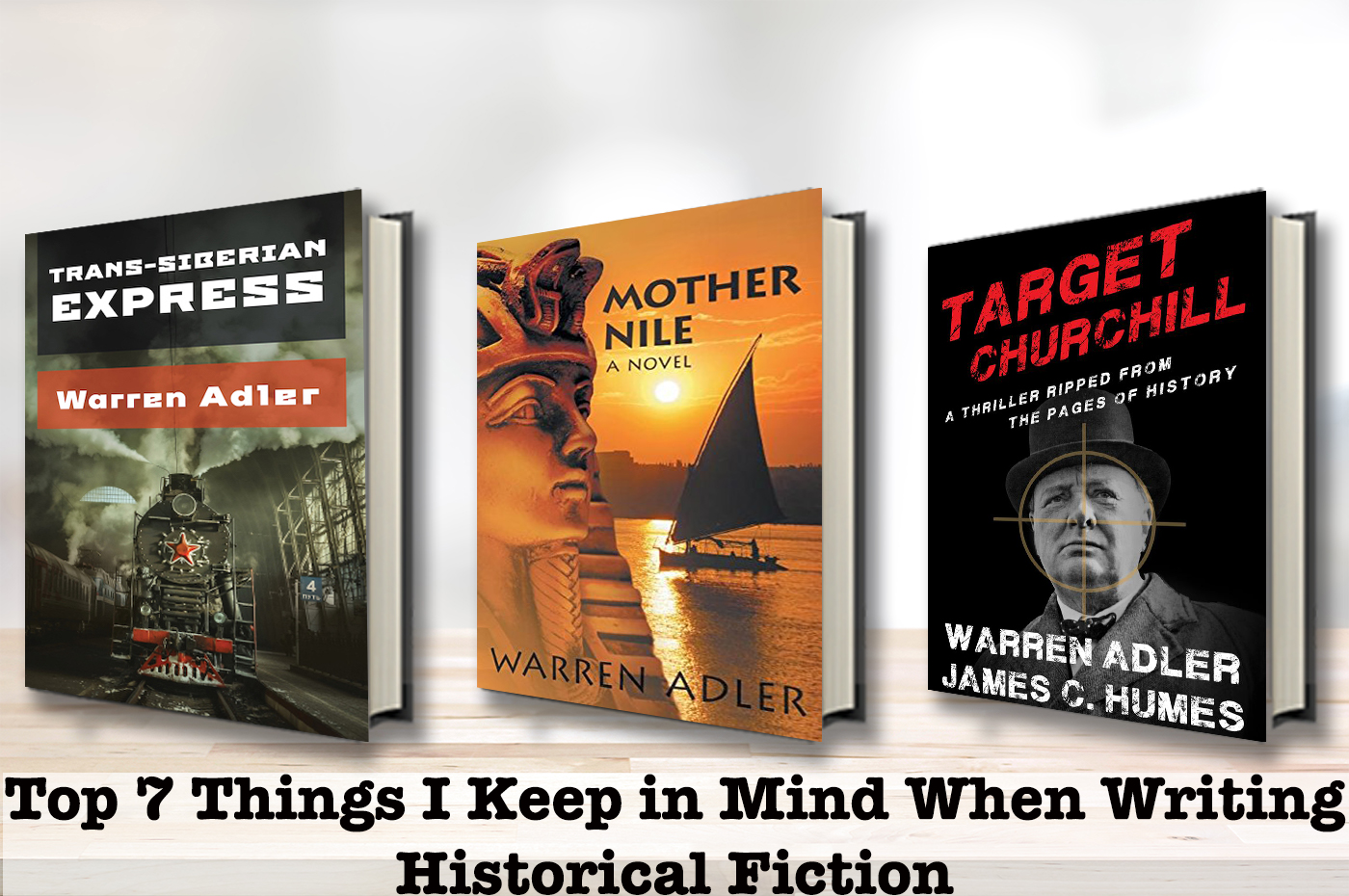Top 7 Things I Keep in Mind When Writing Historical Fiction
I’ve always considered myself a history buff and have written quite a few historical fiction novels requiring exhaustive amounts of research. Creating believable historical fiction means getting facts straight and making sure that your research and imaginative input inspires the most plausible, complex plots and characters you can possibly bring to life. Here I lay out the top 7 components you need to think about when writing historical fiction.
1. Research, Research, Research
Writing historical fiction can be intimidating and you might feel either overwhelmed by the amount of research that is required or constrained by the time period, in turn making your writing flat and boring. If you haven’t done enough research for your novel then it will be evident to readers – the environment you create just won’t have that pull. Doing enough research doesn’t just mean reading up on dates and public figures but delving completely into the historical period you’re writing about. My most popular historical fiction novel, Target Churchill, centers on a fictionalized Soviet conspiracy to assassinate Churchill in order to prevent him from delivering his “Iron Curtain” speech in Fulton, Mo., in 1946. I co-authored the novel with the Pulitzer-Prize nominated Churchill Biographer James C. Humes and spent months reading Winston Churchill’s memoirs, accounts of the events leading up to the Iron Curtain speech; composing his speech in the British embassy in Washington; facts about Soviet spies who had penetrated the embassy during the war; the relationship between Churchill and his lone bodyguard. Walter H. Thompson; details of the Soviet advance into Berlin; events surrounding Truman’s invitation to Churchill to speak at Westminster College in Missouri; the marvelous, true events about the famous poker game on the Presidential train en route to Missouri; and the Churchill family history at the time. It was all grist for the novelist’s mill. My research led to new characters and sub-plots. It was all so rich and intriguing that I could have spent a lifetime on the topic. That research was immensely critical in being able to paint a believable character replete with identifiable insecurities, quirks, strength and weaknesses.
 2. Creating Empathy Through Nuanced, Three-Dimensional Characters
2. Creating Empathy Through Nuanced, Three-Dimensional Characters
The themes in my novels deal primarily with intimate human relationships, the mysterious nature of love and attraction, the fragile relationships between husbands and wives and parents and children, the corrupting power of money, the aging process and other important universal themes that cross cultural boundaries. When writing historical fiction you should always be sure to paint the emotional landscape of your characters within the realities of their specific historical time periods but, most importantly, never lose sight of the fact that the figures you are writing about are human beings plagued with the very same range of complicated human emotions we experience today. As in all good fictional writing, historical figures must be believable. Beyond facts, having the sensitivity to imagine characters in a realistic, emotionally authentic way goes a far way.
My expectation as an author is that exposition, dialogue, character interaction, emotional contact, descriptive details of the environment, authorial insights, and perhaps a sketchy outline of the characters’ physiognomy are all enough to create an image of a character in the reader’s mind. The reader should be well aware of the approximate age of the characters by their impulses and desires, especially in those stories that deal with the mysteries of physical love and motivational impulses like ambition, faith, rapaciousness, depression, yearning and other emotions.
3. Being Genuinely Passionate About the Historical Period and Figures You’re Writing About
What made writing Target Churchill so enjoyable for me is the fact that I am truly a fan of Winston Churchill. I have indelible memories of his speeches, particularly the “Blood, Toil, Sweat and Tears” speech that I heard sitting in my grandparents’ back porch in 1940 after the British retreat on the mainland of Europe. I also remember listening to the Iron Curtain Speech he made in Missouri in 1946. These speeches were an inspiration and moved me immensely. I will never forget them. Churchill is a hero of mine and my biggest goal in rendering his character for the novel was to make him a thoroughly relatable character to readers of today, bringing the more abstract aspects of his humanity to the forefront.
4. Making the Most Out of the Logistical Details in Your Story
Readers want to come away from your work feeling that they’ve learned something new about a particular place and the people living in it. On this front, accuracy is extremely important but you still have room for imagination. I was extremely taken by everything I learned about Russian train engineering when I wrote Trans-Siberian Express but particularly fascinated by the importance of train arrival and departure times to conductors and personnel aboard the Trans-Siberian Express. Much of the interaction of the characters in the story are directly linked to the logistics of timing. Alluding to just one particular aspect of something within your story, in this case, the logistics of train schedules, can offer clever commentary on a society:
That’s the thing about Russian trains. Always on time, to the minute. It’s astonishing, considering the Russians’ lack of efficiency everywhere else.” He flushed suddenly, remembering Mrs. Valentinova
5. Picking Up On the Smallest Details of an Environment Have the Biggest Impact
Evoking the right ambiance in your story means the world when you’re attempting to transport readers into a particular historical period. The more minute the detail, the stronger the impact. Take, for example, this description of Cairo:
Gas fumes permeated everything, and a saffron-coated chickpea stink laced with vague odors of human waste larded the air. A single inhalation, and it could be tasted like some noxious medicinal brew. He was now digesting Cairo, and it lay like lead in his gut.
6. Seamlessly Blending Fact & Fiction
One comment I often receive from readers regarding my historical novel deals with the topic of differentiating fact from fiction. Historical fiction superimposes an imaginative scenario on historical facts and gives imaginary life to real characters while following the course of their reasonably historically accurate lives. Some are taken by the seamless blending of those two worlds and others are confused. I’ve received a countless number of reviews on this topic but one stuck out to me the most for my most recent novel, Mother Nile: “When presented with a story that includes real historical figures and that is set against a backdrop of true historical events, I am always curious to get some sense of where fact ends and fiction begins.” This reviewer suggested using an author’s note that would place my version of events into historical perspective. This is a decision individual authors must make for themselves but I’ve always believed that people who exist in the imagination are just as real as people who exist in the flesh – historical fiction, indeed any kind of fiction, is an exercise in skillfully creating a parallel world where fact and fantasy are fused in a believable way.
7. Avoid Distracting Readers From the Core Plot of the Novel
Although research is paramount to writing high-caliber historical fiction one of the most insidious risks you run is unconsciously allowing technical details to overtake the imaginary plot at the heart of your story. When you’re passionate about the facts you’ve discovered in your research it’s easy to get caught up in placing them all into your work. It’s extremely difficult to decide when to make sacrifices and the trouble here lay in figuring out a way to create a historically accurate cultural landscape while not distracting the reader from the central fictional plot. I wrote Trans-Siberian Express way before the advent of Google and at that time I pretty much haunted the Library of Congress learning as much as I possibly could about Russian train engineering. I had a great time feverishly researching everything I could for that novel but ended up in a situation with my then editor who decided it was best to cut out the majority of the facts I believed to be necessary to the story. Although I was furious at the time, in retrospect, he may well have been right in doing what he did. We all have blind spots. Make sure you’re thinking about your work as objectively as possible.
For a limited time Trans-Siberian Express, Mother Nile, and Target Churchill are only $1.99.


